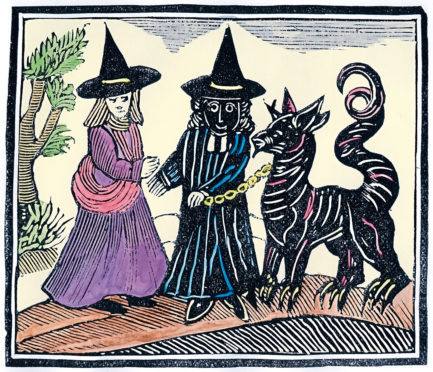
They brandished broomsticks, stirred cauldrons and cast spells – or did they? A new book, A History Of Magic And Witchcraft, debunks some of the myths surrounding witches. Author Frances Timbers tells Stevie Gallacher The Honest Truth about witches and witchcraft
How accurate is the image of witches as lone women stirring cauldrons and brandishing broomsticks?
The answer is both very accurate, and not accurate at all.
Most women accused of being witches were older, widowed women, quite often without a husband or son to protect them, therefore alone in a certain sense.
The inaccuracy of the image in the modern idea of the witch being a woman who lived in a hut on the edge of the forest is somehow out of step with the community.
Women, and men, who were accused of witchcraft were firmly embedded in their communities, which is why they were targeted.
Why were people accused of being witches?
It quite often followed some incident in the village between neighbours. The image of cauldrons and broomsticks arose not from the local villages where the accusations took place, but from the literature produced by the writers, or demonologists as they were known.
The idea of witches flying on brooms and boiling babies in cauldrons was made up.
These didn’t come from accusations from fellow villagers.
Where does the witch’s cat come from?
The concept of the cat is a little more complicated. Small creatures were sometimes seen as animal helpers of the witch, similar to fairies and probably derived from the concept of the fairy or brownie.
The idea that the familiar toad or cat was actually the devil in disguise was also introduced by the demonologists.
Of course, the men, women and children who were accused of being witches or practising witchcraft were not stirring cauldrons, flying on broomsticks, or talking to familiars.
The figure of the witch was a social construction.
Men practised magic – but it seemed to be women who took the blame. Why is this?
Women were “blamed” more often than men. Although the statistics change from country to country, it was 80% women (90% or more in England) who were accused of witchcraft.
The “witch” was often a scapegoat for someone’s troubles. Because the figure of the witch, for the most part, was constructed as a female, women came under suspicion more often than men when things went wrong. This was reinforced by the church, which was quick to point out how weak Eve and her descendants were and more susceptible to the devil.
Is witchcraft older than Christianity?
I hope that I have thoroughly debunked this popular notion in the book. Witchcraft was definitely not a pre-Christian belief system or religion that had been driven underground by Chrisitanity. Witchcraft as a religion or belief system, as in the form of modern Wicca, was invented in the mid-20th Century. However, many ancient, pagan ideas were incorporated into the new system.
How terrifying was the Spanish Inquisition?
No doubt it was extremely terrifying for the many people who came under its purview.
But, in relation to witchcraft, the Spanish Inquisition has acquired a bad reputation.
It was instituted to deal with heresy rather than witchcraft and magic. And, following the big outbreak of alleged witchcraft in Navarre, the Inquisition was very lenient toward those accused of witchcraft. They basically didn’t believe in the phenomenon.
How did Scotland treat suspected witches?
Many more people were accused of witchcraft in Scotland than in England.
The Scots burned their witches, as happened in Europe, rather than hanging them, like in England.

Enjoy the convenience of having The Sunday Post delivered as a digital ePaper straight to your smartphone, tablet or computer.
Subscribe for only £5.49 a month and enjoy all the benefits of the printed paper as a digital replica.
Subscribe